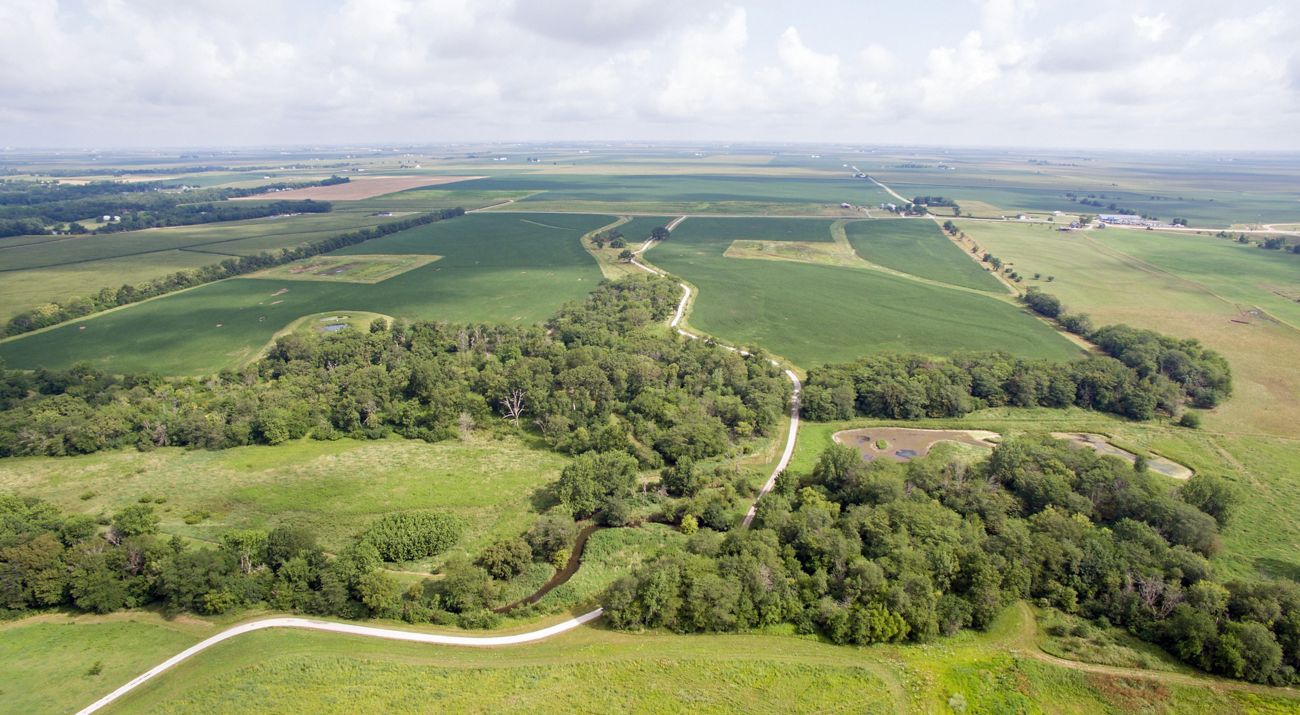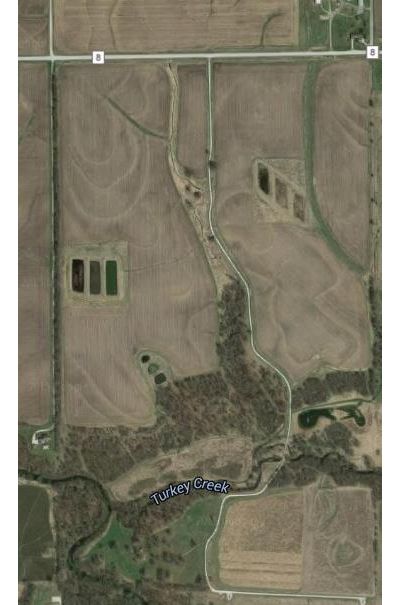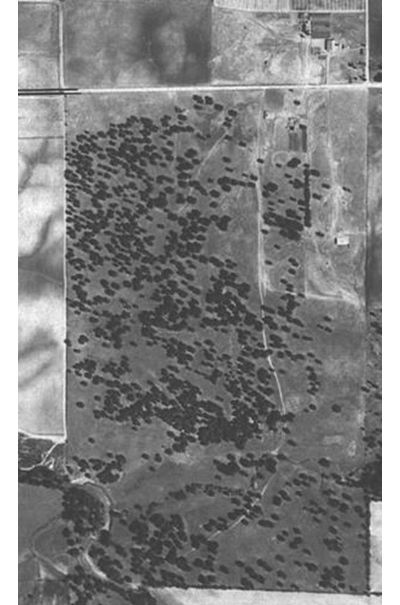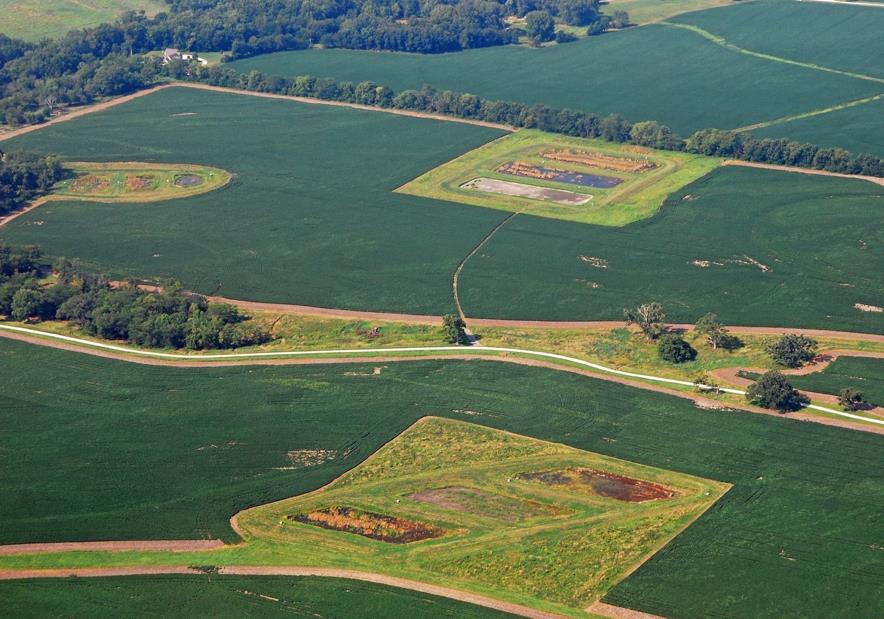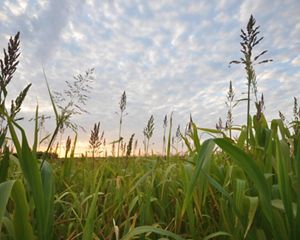Small Wetlands, Big Benefit: How to Harness Nature to Filter Agriculture Runoff
A long-term study of constructed wetlands in Illinois shows a nearly 50% reduction of excess nutrients in agricultural runoff that can damage wildlife habitat and impact drinking water quality.
John Franklin’s farm has been in his family for 170 years. “That’s why I’m into conservation, that long history,” he explains. “We want to keep it going for the next generation.” Along with his brother and other family members, Franklin grows corn and soybeans on his property in Lexington, Illinois, bordering the Mackinaw River.
When he heard that The Nature Conservancy (TNC) was looking for a site to try some innovative farming techniques, he offered up 140 acres of his farm. TNC has been using a portion of this site for experiments since 2005 to explore how constructed wetlands can reduce nutrient runoff from farm fields.
A 12-Year Study on Constructed Wetlands
The results of this long-term study are in: Constructed wetlands are a cost-efficient, long-term, highly effective tool to reduce nutrients exiting fields that could otherwise affect local waterways. A relatively small wetland, around 6% of the tile-drained agricultural area, can reduce nitrogen by nearly 50%. If applied at scale, this approach could help address excess nutrients from farms throughout the Midwest. These types of wetlands are one of many "edge of field" and in-field practices that farms can deploy to support conservation.
"The wetlands do work really well,” says Maria Lemke, TNC’s director of conservation science for Illinois and the lead scientist on the study. “They’re effective over the long term and relatively low maintenance.” Her team found that installing wetlands on the borders of fields reduced both nitrate nitrogen and dissolved phosphorus runoff, significantly improving water quality flowing into downstream stream and river systems.
Negative Impacts of Excess Nutrients
Excessive amounts of nitrogen and phosphorus in water feed an overgrowth of toxic algae. After the algae die, they decompose and are broken down by bacteria, which remove so much oxygen from the water that it's hard for anything else to live there.
Agricultural runoff has long been a serious problem in the Midwest. When excess water flows off fields, it carries nutrients into local waterways, where they can contribute to toxic algal blooms. The nutrients flow to the Mississippi River and ultimately feed the dead zone in the Gulf of America, an oxygen-depleted area that spans nearly 4 million acres. Excess runoff can also strip fields of their fertility, impact drinking water quality and damage wildlife habitat—while also coming at an economic cost to the farmer.
Reducing excess runoff is particularly important in Illinois, which contains some of the most productive land in the country and remains one of the highest contributors of excess nutrients to the Mississippi and the Gulf.

We Can’t Save Nature Without You
Sign up to receive monthly conservation news and updates from Illinois. Get a preview of Illinois’ Nature News email.
Key Takeaways
-
Constructed Wetlands on Farms Can Reduce Water Pollution
Wetlands on farms can remove a significant amount of excess nutrients from runoff and, if applied at scale, can have a huge positive impact on water quality.
-
Even the Smallest Wetlands Make a Difference
Even a small wetland (about 6% of the cultivated area) can slash the excess nitrate nitrogen in water by nearly half and remove more than half of dissolved phosphorus.
-
Positive Impact on the Gulf of America
This nature-based solution can curb excess nutrients from Midwest farms in water flowing all the way down to the Gulf Coast.
How Can Wetlands Reduce Runoff?
In nature, wetlands are havens of biodiversity for wildlife. They also store carbon, and they help to keep an area’s hydrology in balance by wetlands filtering out pollutants, soaking up floodwater and releasing it gradually during dry periods, helping to keep the area’s hydrology in balance. Putting wetlands to work on farms is a practical extension of their function in nature. On the Franklin family farm, Lemke’s team built three sets of wetlands, each with a series of three wetland cells, and measured how much the nutrient load was reduced as the water flowed from one to the next.
The Franklin Farm’s Constructed Wetlands
Three wetland complexes, East, West & Gully, were constructed between 2004 and 2006, each consisting of three wetland cells separated by berms. Water gravity-flows between cells through tiles installed within the berms & perimeter berms prevent surface water runoff from entering the wetlands. Tile systems drain 19.7 acres each for East & West wetland complexes & 9.9 acres for the Gully complex.
Gully Wetland Complex
The 12-year study showed that a wetland representing 3% of the adjacent tile-drainage farm field can successfully reduce nitrate nitrogen levels by 15-38% and dissolved phosphorus by 53-81%.
West Wetland Complex
Results from mid-sized wetlands representing 6% of the tile-drained farmland showed a cumulative reduction of nitrate nitrogen levels in water by 39-49%.
East Wetland Complex
Wetlands representing 9% of the tile-drained farmland saw a cumulative reduction of nitrogen levels in water by a whopping 49-57%.
At times, she said, “we saw the water coming in was carrying 20 milligrams per liter of nitrate, and going out it was 10 milligrams or less.” Wetland plants absorbed some of the nutrients, and microbes converted some into nitrogen gas, an inert, non-greenhouse gas. Wetland plants can also sequester carbon from the air, helping to mitigate climate change.
An important focus of Lemke’s work was figuring out the optimal size of wetland for nutrient reduction. “The last thing we want to do is put in something bigger than you need, because this land is so productive, but we also don’t want to put in something too small to have effective conservation benefit,” she explains. The team compared wetlands that were scaled to 3%, 6%, and 9% of the cultivated area they drained.
Data at a Glance
-
15-38%
of nitrate nitrogen in the water runoff was reduced in the Gully wetland, which represents 3% of the adjacent tiled area.
-
53-81%
of dissolved phosphorus in the water runoff was reduced in the same Gully wetland.
-
48-57%
of nitrate nitrogen in the water runoff was reduced in the East wetland representing 9% of the tile-drained farmland.
“Even the smallest one showed really good reduction of nitrate, about a 15% to 38% reduction, which is really great for these small wetlands,” Lemke shares. The wetlands also removed 53–81% of dissolved phosphorus. Larger wetlands removed more nutrients, but ultimately, Lemke concluded, the size of the wetland should depend on landowner preferences and goals for nutrient reduction.
The team worked with Dr. David Kovacic, an environmental science professor at the University of Illinois; the Natural Resources Conservation Service (NRCS); and the local Soil and Water Conservation District. A local contractor constructed the wetlands, and wetland plants colonized the wetlands on their own, either from seeds that had been in the soil or from wind dispersal. The wetlands were enrolled in the U.S. Department of Agriculture’s Conservation Reserve Program (CRP) and Environmental Quality Incentives Program (EQIP), and funding from the state Department of Natural Resources, NRCS, a federal Conservation Innovation Grant and in-kind assistance from AGREM, LLC, made the work possible.
Support Our Work in Illinois
You can help us do important conservation work in the Mackinaw River Watershed and beyond.
Donate NowNext Steps: Installing Constructed Wetlands on Midwest Farms
Like many farms in the region, the Franklin farm uses tile drainage to remove excess subsurface water from the soil so that it can be cultivated. Water percolates through the soil into a system of plastic tubes and travels through these tubes into the experimental wetlands. Lemke and her team measured nutrient levels in the water entering and exiting each of the wetlands.
Next, the team will examine how combining wetlands with various in-field practices might reduce the overall footprint of these approaches. They’re tinkering with in-field variables such as the timing of fertilizer application and the use of cover crops, which protect soil during the non-growing season.


Though the benefits of wetlands for water quality are clear, installing a wetland is still a difficult task that requires the services of an expert contractor, and the costs of design and construction can run into the tens of thousands depending on wetland size. Farmers can receive compensation for the expense through CRP, EQIP and other programs, but they often must pay out of pocket and wait for reimbursement. In addition, although putting a wetland on their property provides an enormous environmental service, landowners see few personal benefits from them.
“We need to make it easier to do this,” Lemke says. “Landowners need better incentives, such as 100% reimbursement of construction costs and 120% annual rental rates, because they’re providing a benefit to downstream users.” She notes that they could also benefit from technical assistance to apply for cost-share programs, manage the construction and keep up with minor maintenance of the wetlands over time.
Twelve Midwest states, including Illinois, participate in a compact to reduce nutrient loss to waterways. Adding more constructed wetlands to farms could help Illinois meet its goals for nutrient reduction. But the practice needs to be widely adopted to be effective. That’s where assistance to farmers and promotion of the practice by the state could make a difference.
“We have a long way to go,” Franklin says, “but farmers have an incentive to do this, to become part of the solution in reducing nutrient runoff. Everyone lives downstream from someone."
